The Sublime Iconoclasm of John Divola
The American photographer John Divola has prepared a set of unpublished works for this edition of Electra. They are part of an ongoing series located in an air force base in the California desert that was decommissioned after the Cold War came to an end, and which has since remained like a veritable city in ruins. It is not the first time that John Divola aesthetically intervenes in abandoned spaces and then captures the results on film. As Afonso Dias Ramos demonstrates in the following essay introducing Divola’s work, the visual explorations that have been undertaken during this pandemic actually take up the artistic strategies that had marked his early oeuvre, in a surprising throwback of nearly half a century that is also a revisitation of contemporary art history. The images shown in this «Scoop» foreground ruins as a way to reposition photography in direct interaction with painting, sculpture, and installation, and thereby declining any distinctions between the witness or the participant, between the intervention and the document.

John Divola, Blue with exceptions, 2021. Courtesy of the artist.
John Divola was born in Los Angeles in 1949. He studied at California State University, Northbridge, and completed an MFA at UCLA under Robert Heinecken, a major figure on the Californian arts scene who alongside John Baldessari and Ed Ruscha called for the use of photographic cameras as a way of subverting artistic discourse. In the mid-1970s, and without a studio of his own, Divola began walking the streets looking for vacant houses.
After stepping into them, he vandalised the interiors with spray, paint and matches, recording the results on film. This conceptual sabotage of the distinction between documentary and artistic practice earned him instant critical acclaim, and was the beginning of a fifty-year career that witnessed some of the most distinctive works in contemporary art, aligning photography in a very particular way with painting, sculpture, performance and installation. Divola has taught photography since 1988 at the University of California, Riverside. He has taken part in over two hundred collective and eighty solo shows internationally, and his works are part of the most influential international art collections, including MoMA, MET, the Whitney Museum in New York, the Centre Pompidou in Paris, the Getty Museum and LACMA in Los Angeles, the Smithsonian in Washington, the Tokyo Metropolitan Art Museum, and the V&A in London. He has published seven books: Continuity (1997), Isolated Houses (2000), Dogs Chasing My Car In The Desert (2004), Three Acts (2006), Vandalism (2018), Chroma (2020), Terminus (2021). In this ‘Scoop’, Divola shares with Electra previously unreleased material from a series in progress entitled Blue With Exceptions, made over the past two years at a decommissioned military base in the California desert.



John Divola, Blue with exceptions, 2021. Courtesy of the artist.
What are those blue remembered hills
[…] That is the land of lost content,
I see it shining plain,
The happy highways where I went
And cannot come again.
A. E. Housman, A Shropshire Lad, (1896)
John Divola’s latest book, Terminus (2021), brings together a series of black-and-white photographs taken since 2015 inside George Air Force Base – a closed military installation in California seventy miles from Los Angeles on the southwestern edges of the Mojave Desert. While the project was initially given official permission to photograph the outside areas, most of it was the result of the artist’s clandestine explorations of the interiors of 600 housing units that had been abandoned after the military base was closed down in 1992. The artistic intervention in these derelict buildings, with the subsequent records of modified scenes, is part of a revisitation of Divola’s work – and by extension, of the history of photography and contemporary art. He picked up on his earlier approaches after half a century of work in Los Angeles, and went on to explore different practices, maintaining a sharp contrast between projects, from the series on isolated houses to sequences of dogs chasing his car through the desert; and from the use of robotic cameras for landscape shots to the use of timers to create self-portraits on the run. A rarity in the artistic panorama of our times, this dialogue with his earlier work was not intended to rehash old formulas, but rather to emulate the experimental impetus that had set him apart as one of the first conceptual artists to question the limits of photography, refusing the then dominant patterns of neutrality, and using colour exuberantly at a time when black-and-white was still considered the most serious form of art. Dating back to the 1970s, this procedure found new possibilities in the derelict air base, with work that, just as before, now fundamentally rested on the negation of a distinction between witness and participant, document and intervention, and the intersection of photographic practice with other visual arts as part of an exploration of perception, space, and surface. Such time travel, however, is no accident. According to documentary tradition, this extensive fieldwork in the military installation took place in parallel with a return to his private studio archives. John Divola turned back to old negatives because of the book Chroma (2018), developing new experiences with the saturated and artificial pigments of obsolete Cibachromes; and he refamiliarised himself with his own legendary series in which he intervened in abandoned houses, Vandalism (1974-75) and Zuma (1977-78), as these underwent a process of digitalisation and republication.
[...]

John Divola, Blue with exceptions, 2021. Courtesy of the artist.
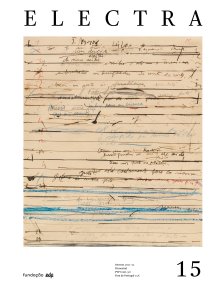
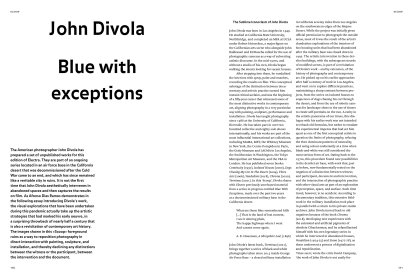
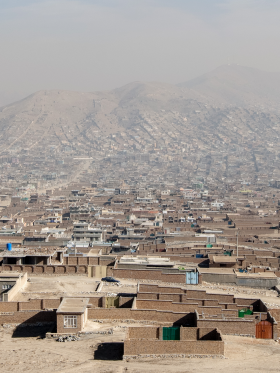
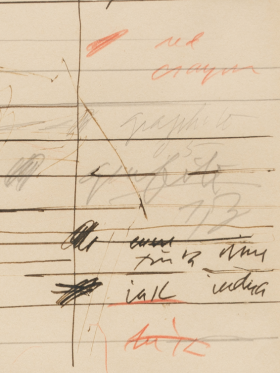
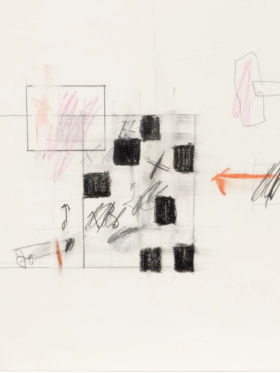
Share article